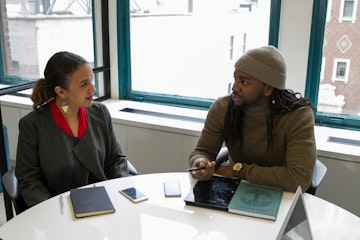Curriculum Spotlight
Learning Product Design with Flatiron School

![]()
Written By Jess Feldman

![]()
Written By Jess Feldman
Course Report strives to create the most trust-worthy content about coding bootcamps. Read more about Course Report’s Editorial Policy and How We Make Money.
Course Report strives to create the most trust-worthy content about coding bootcamps. Read more about Course Report’s Editorial Policy and How We Make Money.
Flatiron School took feedback from their design hiring partners to create the new Product Design program. We caught up with Flatiron School’s Director of Product Design Education, Giovanni Difeterici, to learn how the product design curriculum is preparing students to adapt to employers’ needs. Find out if you’re the ideal student for this bootcamp, what you’ll learn in the design Studio experiences, and what types of jobs you’ll be prepared for in the design industry when you graduate.
Giovanni, what is your role at Flatiron School?
I’m the Director of Product Design Education at Flatiron School. I oversee the academic side of the Product Design program, which essentially boils down to being the product manager for the program, overseeing the curriculum and central teams, and then collaborating with the rest of the departments to ensure that the program is successful.
What exactly is product design? How is it different from UX/UI design?
User experience (UX) and user interface (UI) are the raw skills and tools that a product designer relies on to perform their tasks. When creating products, UX tends to be front-loaded, meaning that large amounts of energy are dedicated to testing a research to validate product ideas. UI and web development often happen later in the product design process. The two skills, UX and UI, are often seen as discrete skill sets, though closely related. Product Designers take a slightly different view by developing strong capabilities in UX and UI and sometimes code. Product Designers are generalists that can operate at many levels in the product development process. This gives them a deep understanding of the needs of stakeholders and of the constraints and opportunities inherent in building digital products.
In the past, Flatiron School taught a UX/UI Design bootcamp – why pivot to Product Design?
We did a lot of market research on where the industry was headed, and there was interest in entry-level candidates with a more general design skill set rather than UX/UI job candidates with only research-heavy or visual-heavy skills.
How is the new product design program different from the old UX/UI design bootcamp?
In the old UX/UI program, all the students studied a common core, and then they would specialize in either UX or UI. This meant they would graduate from the bootcamp with either a UX or UI portfolio. Feedback from past students and instructors helped us understand that this was too narrow, so the biggest structural change in the new Product Design program is that students will be learning both UX and UI, and not specializing in a single skillset. The goal of this change is to give our students a deep and wide set of skills that make them suitable for many UX/UI environments and positions. It also allows students to explore their innate aptitudes for research and design and then build a portfolio that showcases their strongest skills.
What will students learn about product design in the bootcamp curriculum?
The new curriculum is divided into five phases. The first two phases are focused on foundational UX and UI skills.
Phases 3-4 are Studios featuring bigger projects where students direct their own work and process. We give students the source material, set up the problem statements, and function as each student’s manager. Studios serve as an opportunity for students to explore what they learned in the earlier phases and start learning how to lead a project toward completion.
Our hiring partners gave us feedback that it’s essential for entry-level product designers to have a basic understanding of HTML and CSS. We cover the basics of HTML and CSS early on so that students can play with it on a project-level. When students are building their portfolio in Phase 5, we spend more time on HTML and CSS.
What will a typical day look like for a student learning Product Design at Flatiron School?
The structure is pretty straightforward. Most days, there’s a lecture in the morning and then we have what are called Design Labs. On a typical day, there could be one or two design labs.
In the first phases, the relationship is much more student-instructor focused and it’s very guided. In the studio phases, it’s more of a junior-level employee and lead manager relationship. The instructor’s role is a little different, but it’s to help the students understand what it will be like in a work environment where your feedback is qualified, you have to meet deadlines, and you have to meet requirements for projects.
Will students be working on real-world projects with actual clients?
In our new Product Design Program, students complete two Design Studios. Studios incorporate projects based on real world scenarios and turn them into something actionable for the students. The two Studios teach students essential skills like good research, product validation, project management, and deadline management. They can deepen their knowledge, but go beyond the creation of typical UX/UI deliverables. Our goal with the studios is to provide a realistic experience while also ensuring consistent outcomes.
Are there opportunities for students to work collaboratively together on those Studios or are these solo projects?
Studios and Design Labs are particularly collaborative and give students scaffolding opportunities. Group projects are a great way for students to explore the topics they’re learning about together. Group projects are about critique and evaluation, as well as forming and defending opinions. Students can work together on projects, but they have to produce their own artifacts so we can grade them individually.
Even though you’ll work together in the studios, you are graded individually on your own project work.
What is the difference in learning style between the Live and Flex options?
The Product Design bootcamp is offered online, and students can choose between Live or Flex.
Who are the instructors for Flatiron School’s product design bootcamp?
The product design instructors are all dedicated instructors and all of them have industry experience. We have two teams of instructors: the central lecture team and the delivery team.
Two of our central lecturers are:
We rely on collaboration between our central lecturers and delivery team to support our product design students.
Is there an ideal student for the Product Design program?
The product design bootcamp is oriented towards career changers, but upskillers with a basic understanding of UX/UI design may also benefit from this bootcamp. In the first two phases of the product design course, we’re anticipating that students will have no experience.
As part of the admissions process, candidates must complete a 20-hour, pre-work phase. The pre-work is intended to put all students on equal footing when they start the product design bootcamp. The pre-work will introduce them to ideas they may never have heard before, attempt basic processes and tooling, and give them a glimpse of what they're getting into.
What kind of career services can Product Design bootcamp students expect?
For both Live and Flex program options, students receive career coaching, which is committed to helping them find their first interviews and jobs. We also have employer partnerships, and from there we can develop opportunities for the students.
What sort of jobs can product design graduates expect to land?
Graduates can expect to land design roles, such as but not limited to:
What’s your advice for students who want to get the most out of Flatiron School’s Product Design Bootcamp?
Since this is a bootcamp experience, it will cover a lot – more than you think! There’s a lot of information and project work. You will need to dedicate a significant amount of time to the bootcamp, but it’s absolutely worth it.
Before applying to the bootcamp, I recommend prospective students take time to explore general UX/UI and product design topics first. The more students can do to explore these ideas, the better. Product design is a great field to be in! It takes a lot of skill sets that some people might not associate with each other to be successful in this industry, but a career in UX/UI is very achievable. Come in with an open mind and a willingness to dig in and you’ll do just fine.
Find out more and read Flatiron School reviews on Course Report. This article was produced by the Course Report team in partnership with Flatiron School.

Jess Feldman, Content Manager at Course Report
Jess Feldman is an accomplished writer and the Content Manager at Course Report, the leading platform for career changers who are exploring coding bootcamps. With a background in writing, teaching, and social media management, Jess plays a pivotal role in helping Course Report readers make informed decisions about their educational journey.










Sign up for our newsletter and receive our free guide to paying for a bootcamp.
Just tell us who you are and what you’re searching for, we’ll handle the rest.
Match Me